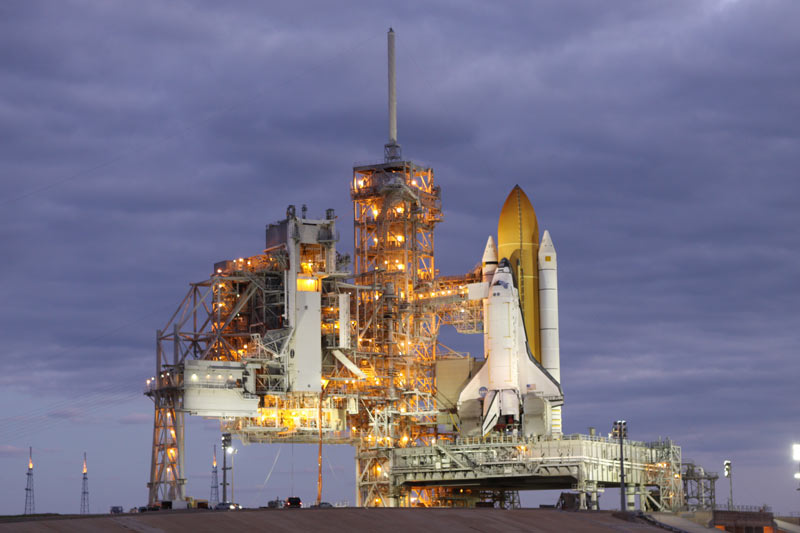NASA Engineers Examine Space Shuttle Discovery Ahead of Repairs

NASA engineers are beginning their examination of the fuelleak that stalled last week's launch of the space shuttle Discovery to theInternational Space Station.
Engineers are taking steps to remove and inspect thecomponent where the leakwas discovered on Discovery's huge orange external fuel tank. Early work tostudy a 20-inch (51-centimeter) crack in the fuel tank's foam insulation isalso planned for this week, NASA officials said.
"Right now they're basically trying to gather as muchinformation as possible before they start actually making repairs for any ofthe issues that we're working," NASA spokesman Allard Beutel toldSPACE.com. "It's not a matter of simply making the repairs. They want toknow what caused this in the first place."
NASA is now hoping for a Nov. 30 launch date for Discovery'sfinal flight before it is retired along with the rest of shuttle fleet in 2011.
The hydrogen gas leak was detected Nov. 5 as Discovery's15-story external tank was being filled with liquid oxygen and liquidhydrogen ? the cryogenic propellant that powers the shuttle's three mainengines during liftoff and ascent into orbit.
Discovery's fuel tank leak
The leak was in the ground umbilical carrier plate, or GUCP,which is an attachment point between the external tank and a 17-inch (43-cm)pipe that carries gaseous hydrogen safely away from the shuttle to the flarestack, where it is burned off. NASA encountered similar leaks on two previousshuttle missions but wants to understand how the latest event occurred.
Get the Space.com Newsletter
Breaking space news, the latest updates on rocket launches, skywatching events and more!
Engineers are expected to record measurements as the shuttlestands on its seaside launch pad at NASA's Kennedy Space Center in Florida. Ananalysis will be performed after the GUCP has been removed, and Discovery'sSTS-133 mission managers will then assess repair options.
Tank crack concerns
A crack in the foam insulation of the shuttle's externaltank was also found during an inspection following Discovery's scrubbed launch.
The roughly 20-inch crack is located in the inner foam on adifferent part of the tank than the fuel leak. It is more than twice as long aspreviously thought. NASA initially estimated the crack at 7 inches (almost 18cm) long, mission managers said. [Photo of the cracked foam]
Beutel said that while work on the leaking fuel line willbegin today (Nov. 9), engineers are not expected to begin work on the foamuntil Wednesday.
Technicians studying the crack will use non-destructive terahertzor X-ray scans to look beneath the foam for any other potential hazards.
NASA is extremely wary of any large cracks in the foaminsulation that coats space shuttle fuel tanks, because debris from the crackspose a danger to the shuttles during flight.
Foam debris that separated during the launch of the spaceshuttle Columbia in 2003 led to the loss of that shuttle and itsseven-astronaut crew as the spacecraft re-entered Earth's atmosphere forlanding.
Since then, NASA has instituted measures to reduce theamount of foam on shuttle fuel tanks, and technicians perform severalinspections before launch.? Astronauts also inspect their shuttle heat shieldsfor damage while they are in space, using robotic arm-mounted sensors.
While NASA studies the problems, Cmdr. Steve Lindsey and pilotEric Boe, who flew back to NASA's Johnson Space Center with their fellowSTS-133 crewmembers following Friday's launch postponement, planned to return todayfor a series of training exercises in the agency's shuttle training aircraft.
The next possible time that Discoverycan attempt a liftoff to the International Space Station is Nov. 30 at 4:05a.m. EST (0905 GMT). Discovery is scheduled for an 11-day supply mission to thespace station to deliver a humanoid robot helper for the station crew and a newstorage room for the orbiting lab.
The STS-133 mission will be Discovery's grand finale inspace beforebeing retired.
- GRAPHIC:NASA's Space Shuttle ? From Top to Bottom
- Gallery:Building Space Shuttle Discovery
- Video? Space Shuttle Discovery: A Retrospective, Part2, Part3
SPACE.com Managing Editor Tariq Malik contributed to thisreport.
Join our Space Forums to keep talking space on the latest missions, night sky and more! And if you have a news tip, correction or comment, let us know at: community@space.com.

Denise Chow is a former Space.com staff writer who then worked as assistant managing editor at Live Science before moving to NBC News as a science reporter, where she focuses on general science and climate change. She spent two years with Space.com, writing about rocket launches and covering NASA's final three space shuttle missions, before joining the Live Science team in 2013. A Canadian transplant, Denise has a bachelor's degree from the University of Toronto, and a master's degree in journalism from New York University. At NBC News, Denise covers general science and climate change.









